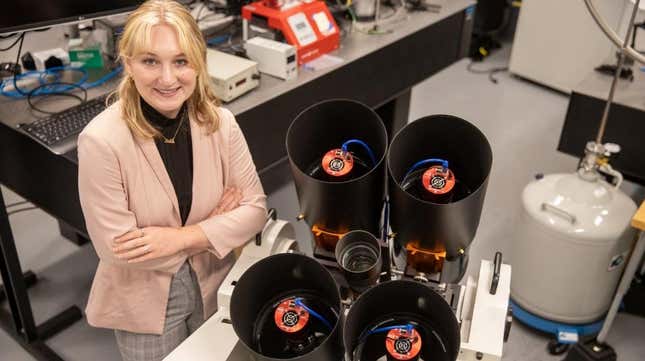
A system built by researchers from the University of Arizona is designed to warn astronomers of particularly bright satellites, affording them time to avert their telescopic eyes.
The team used its satellite tracking device—a small sensor fitted with a camera lens—to measure the brightness and positioning of SpaceX’s Starlink satellites. Over the course of two years, team members performed 353 measurements of 61 satellites belonging to the private company.
“Until now, most photometric—or brightness—observations that were available were done by naked eye,” Grace Halferty, an aerospace and mechanical engineering student said in a statement. “The satellites are challenging to track with traditional astronomical telescopes, because they are so bright and fast-moving.” Halferty is the lead author of the research, recently published in the Monthly Notices of the Royal Astronomical Society.
To make sure the sensor was accurate, the researchers compared their observations to government satellite tracking data from the U.S. military’s Space Track Catalog database. The difference in the data was very slight—an average of 0.3 arc seconds (an arc second is about the size of a dime held 2.5 miles away)—a difference the researchers said is likely due to natural lag times in the government data.
The newly developed sensor could be used to alert astronomers to potential problems, allowing them to halt their ground-based observations should a bright satellite be detected nearby. Satellites interfere with telescopic images by creating bright streaks across the lens’ view, as many satellites are equipped with solar panels that unwillingly reflect sunlight back down to Earth.
“As other [satellite] constellations are added, the problem will only get worse for ground-based astronomical surveys,” said Tanner Campbell, a graduate research assistant at the University of Arizona’s Department of Aerospace and Mechanical Engineering. Campbell estimates that 30% of all telescope images will be impacted by at least one satellite trail once the Starlink megaconstellation is complete.
Elon Musk’s SpaceX is building out a constellation of internet satellites in low Earth orbit, with plans to launch a total of 42,000 satellites. To date, over 2,600 Starlink satellites have been launched as part of the project, which provides broadband internet to paying customers. Astronomers have expressed great concern over this tremendous influx of satellites and how bright they are in the sky. The company has made some effort to decrease the brightness magnitude of its satellites, using a shade to block out some of the sunlight, thereby making the satellites 1.6 times fainter than they were originally. At the same time, SpaceX is gearing up to launch Starlink 2.0 satellites, which astronomers fear will be a full magnitude brighter than their predecessors. With thousands of the Starlink satellites in space, and additional plans by other companies like Amazon to send over 3,000 satellites to low Earth orbit, it is not looking good for our future views of the cosmos.
Frustratingly, the idea of using a sensor to warn astronomers of potential interference is also not ideal. Shutting off a telescope’s camera requires electricity, so it’s akin to powering down a desktop computer and turning it back on again—but in this case the computer is a rather expensive and gigantic instrument that’s used to make sensitive observations of distant objects in the sky. As a consequence, this method has the potential of driving up cost and lowering efficiency for studies of the universe.
There might be hope still to come. The International Astronomical Union established the Centre for the Protection of the Dark and Quiet Sky from Satellite Constellation Interference, and SpaceX has been in talks with the union to figure out ways of reducing interference with telescopes. Combined with efforts like the one from the University of Arizona, our future views of the cosmos may not be as fuzzy as we feared.
More: Glowing Nighttime Clouds May Be an Unexpected Side Effect of Rocket Launches.